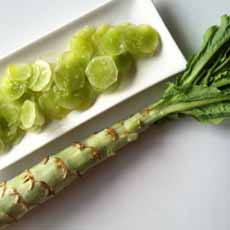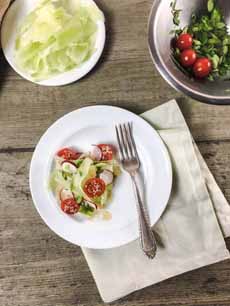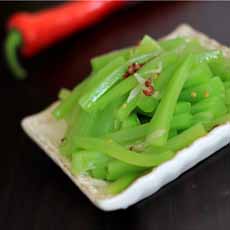TIP OF THE DAY: Celtuce, Stem Lettuce
|
It’s a happy day when we discover a new food. We discovered celtuce [photo #1] in our local Chinatown. There are a number of fruits and vegetables in Chinese cuisine that are unfamiliar to non-Chinese Americans. They move slowly into the hands of mainstream American chefs, and then trickle down to home cooks. One of these is celtuce (sell-TOOSE): not new, but new to us. Celtuce, Latuca sativa, is a member of the same genus and species as bibb, iceberg, romaine and the other lettuces. It is also known as stem lettuce, Chinese lettuce, asparagus lettuce and celery lettuce. The Cantonese name is wosun. (Here’s the history of lettuce and the different types of lettuce.) The sword-shaped leaves look like they’re related to romaine; the stems are pale and long but thick, like broccoli. As you can see in photo #1, celtuce stems have horizontal ribs, which remind us of bamboo. The name is a portmanteau of celery and lettuce,” and—surprise!—it tastes like a blend of both, crisp, delicate, and mild. The flavor is mild with notes of nuttiness to it. Some people find a smoky aftertaste. The stems have the crunch of celery; when eaten raw they will appeal to fans of jicama and water chestnuts. They retain their crispness when cooked. Chefs love celtuce. Chef April Bloomfield thinks celtuce a most underrated vegetable, describing it as “slightly nutty and totally amazing.” [source] For a new taste treat, seek it out. In Asia, the lettuce is grown primarily for its stem; so if you purchase it in an Asian market, the leaves may have been cut off. Buy it for starters, but if you like bitter greens, persist in seeking stems with their leaves. And as many vegetables and fruits have different flavors depending on subspecies and soil, some raw stems can be very bitter; i.e., not good for eating raw. Some varieties don’t have a thick head like romaine, but more of top leaves like a plumed bird or Sideshow Bob. Nutritionally, celtuce is largely water (like celery and lettuce, but with: Celtuce is as easy to prepare as broccoli. Both the leaves and the stem can be served raw or as a cooked vegetable. Like some broccoli, the stem’s outer skin can be tough, and should be peeled. Then, start with this lista: Don’t forget the tomatoes, onions and fresh herbs [photo #2]. |
|
|
|
|
||






